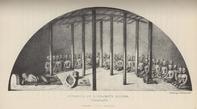Shaka’s Glass Bead Wealth

In the 1820s, the first Zulu king Shaka established control over trade networks in south-east Africa, thereby ensuring his role in the distribution of glass beads and other imported goods entering the region through Delagoa Bay in present-day Mozambique.
Initially, all imported beads were reserved for the king and his immediate entourage, such as women from the king’s homestead. At the time of his death in 1828, Shaka’s personal property amounted to several tons of beads, brass and various other valuable items, all of which was buried with him.
When the artist George Angas visited the third Zulu king Mpande in 1847, he was astonished by the large number of beads worn by women he referred to as the king’s ‘daughters’, young women who had been ‘given’ to the king by homestead heads, thereby enabling him to secure massive herds of cattle through bridewealth payments.
Angas reported that, on festive occasions, the beaded garments worn by these women were so heavy that they found it difficult to dance in them. Strung and restrung over time, beads usually have a very long use-life.
Second Zulu King, Dingane’s Appreciation for Beads

The second Zulu king, Dingane, had a reputation for promoting the arts. He took a keen personal interest in dancing and praise singing. He also employed specialist carvers and metalsmiths to produce prestige items like hardwood chairs and brass neck rings, and is known to have expressed a desire to develop an independent glass beadwork industry in the Zulu kingdom.
Dingane commonly wore beautifully crafted beadwork garments on special occasions. When the British missionary, Francis Owen, attended a meeting at the royal homestead of the second Zulu king, Dingane, in the late 1830s, the twenty-one posts supporting the king’s reception chamber were covered from top to bottom with beads of various colours.
Dingane expressed a fervent desire to find someone who could teach the art of beadmaking to his subjects, interrogating several visitors on the origin and composition of glass trade beads.
Timuni, Nephew of Shaka, Dingane and Mpande

A member of the Zulu royal family, in the late 1830s Timuni fled from the Zulu kingdom to the Colony of Natal after incurring the wrath of the second Zulu king, Dingane, who sentenced him to death for buying a red blanket from European traders.
At that time, blankets of this colour were reserved for the king, as were large red beads and several other bead types and colours.
Timuni settled south of the Thukela river near the Mvoti mission station, where there were no restrictions on the acquisition of either beads or blankets. His image was recorded by the artist, George Angas, who described him as a man of “splendid appearance”.
By Professor Sandra Klopper